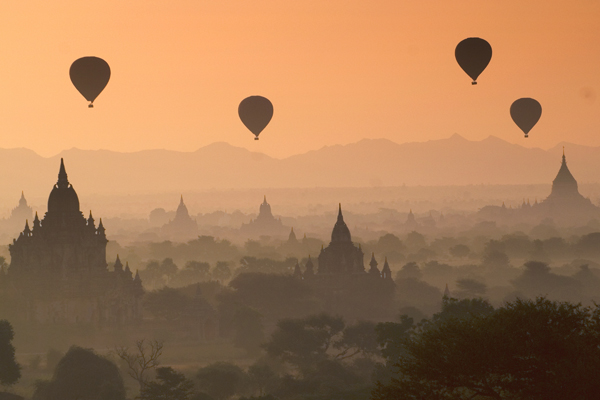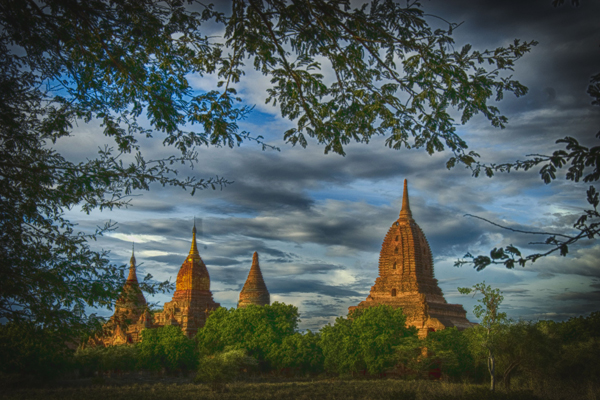Information about Bagan
Bagan in central Burma is one of the world’s greatest archeological sites, a sight to rival Machu Picchu or Angkor Wat but – for the time being at least – without the visitors. The setting is sublime – a verdant 26 square-mile plain, part-covered in stands of palm and tamarind caught in a bend of the lazy-flowing Irrawaddy (Ayeyarwady) river and framed by the hazy silver-grey of distant mountains.
Rising from the plain’s canopy of green are temples, dozens of them, hundreds of them, beautiful, other-worldly silhouettes that were built by the kings of Bagan between 1057 and 1287, when their kingdom was swept away by earthquakes and Kublai Khan and his invading Mongols. Some 2,230 of an original 4,450 temples survive a legacy of the Buddhist belief that to build a temple was to earn merit.
Most are superbly preserved or have been restored by UNESCO, among others, and many contain frescoes and carvings and statues of Buddha, big and small. Only a handful are regularly visited, and though tourist numbers are increasing and the hawkers are beginning to appear, this is still, by the standards of sites of a similar beauty and stature, a gloriously unsullied destination.

Top attractions in Bagan
Bagan’s Top Attractions
Ananda Temple
This temple is one of the few remaining examples of Mon architecture; it was damaged during a 1975 earthquake but has been successfully restored. The Ananda Temple is recognized as the best preserved and most revered of Bagan temples.
Bagan Archaeological Museum
This Bagan attraction was officially opened in 1998. Tourists who want to explore the history of Old Bagan can visit the museum to see objects used during the Bagan period. The first floor houses the showrooms for visual arts and coiffures of court ladies, while the second floor has display rooms with religious themes.
Opening Hours : 09:30-15:00 daily except Mondays and public holidays.
Bu Pagoda (Bu Paya)
The name of this Bagan attraction already gives a perfect description of the place: Bu Paya means ‘a gourd-shaped pagoda.’ According to legend, Pyusawhti rid the area of ‘bu,’ which was a gourd-like climbing plant that infested the riverbanks. As a reward, he became the heir to the throne of Bagan and its third king.
Dhammayangyi Temple
The Dhammayangyi Temple is one of the four major Bagan monuments and ranks alongside Shwezigon Pagoda, Ananda Temple and Thatbyinnyu Temple in importance. Its grandiose architectural plan is similar to Ananda Temple and was built by King Narathu, also known as Kalagya Min, ‘the king killed by Indians.
Gawdawpalin Temple
The Gawdawpalin Temple is one of the biggest shrines in Bagan, and the most imposing because of the Buddha images to be found on the ground floor. The building of the two-storey temple was commenced by King Narapatisithu but it was his son who completed the construction. The name of the temple means ‘the throne which has worshipped.’
Htilominlo Temple
Like the Shwezigon Pagoda, the Htilominlo Temple can be found in the Nyaung U and Wetkyi-In region of Bagan. The 46-metre, three-storey temple was built in 1218, during the reign of King Nantaungmya. It is said that the name is a misreading of the Pali term for ‘Blessings of the Three Worlds.
Myinkaba
Myinkaba, a village just to the south of Old Bagan, is famous for its traditional Mon-style lacquerware, the manufacturing of which dates back to the time of King Manuha, the last king of Thaton, who brought his artisans with him into exile here in the 11th century. Myinkaba is a centre for bamboo weaving (for use in construction) and has several family-run lacquerware workshops, including the Golden Cuckoo; if you want to take a memento home with you, it offers the best range of shopping in Bagan.
Shwegugyi Temple
Built by Alaungsithu in 1311, this temple is an early example of a transition in architectural styles, which resulted in airy, lighter buildings. The temple is also notable for its fine stucco carvings and for the stone slabs in the inner walls.
Shwezigon Pagoda
The Shwezigon Pagoda is considered as Bagan’s most significant shrine. It is said that the structure was built to enshrine one of the four replicas of the Buddha’s tooth in Kandy, Sri Lanka. The construction was started by King Anawrahta, but the project was not completed until the rule of King Kyanzittha.
Sulamani Temple
Found in the Minnanthu region in the centre of Bagan, the Sulmani Temple is a sight to behold. Just like the Htilominlo Temple, the Sulmani Temple displays a more sophisticated style however the Sulmani has better internal lighting than Htilominlo. The name ‘Sulmani’ means ‘Crowning Jewel’ or ‘Small Ruby.
Thatbyinnyu Temple
This 61-metre tall temple is the highest in Bagan. The towering structure gets its name from the Omniscience of the Buddha, as ‘thatbyinnyu’ means omniscience in the Myanmar language. Built in the 12th century by King Alaungsithu, it is one of the earliest examples of two-storey temples.
Activities Outsides Bagan
Mount Popa
A visit to Bagan would not be complete without a trip to Mount Popa. Considered as one of the most popular pilgrimage spots in Myanmar, Mount Popa is an extinct volcano where the Popa Taungkalat Monastery is found. Popa used to be called the ‘Mountain of Spirits,’ and is still recognized as a dwelling of ‘nats,’ or spirits of ancient ancestors.
Location: 50 kilometres from Bagan, Popa region, Kyaukpadaung Township.
Salay
Salay is a colorful old religious center in Central Myanmar it is about 1 ½ hours south of Bagan. In between visiting the numerous ancient monasteries, adorned with beautiful woodcarving, you can enjoy the beauty of this compact city of colonial buildings, monasteries and pagodas.
Visit the famous monastery “Yoke-Sone-Kyaung” which is a cultural heritage site in Salay, which in situated on the eastern bank of the Ayeyarwaddy River. It is famous with its spectacular woodcarvings and also it is the native town of the famous writer Salay U Pone Nya during the time of the Myanmar Kings.
Salay Yoke Sone Kyaung was built in AD 1882. There are very beautiful artistic work woodcarvings around it and also ancient Buddha image, utensils of Yadanabon 19 century period, and the museum of Myanmar famous writer U Pone Nya in Salay Yoke Sone Kyaung.
How to get to Bagan
Air
By far the easiest, most comfortable and quickest way to get to Bagan is by airplane. Nyaung U airport is just a few kilometers away from Old Bagan.
Bus
Day and night buses roll through Bagan every day from every location in Myanmar you’re likely to hit (Myanmar, Inle Lake/Nyaungshwe, Yangon, Pyay etc).
Train
Train service available from Mandalay and Yangon (among others), but it’s a particularly slow and uncomfortable experience. However, it’s one of best way to discover the natural beauty of Myanmar. Trains are overnight departure and it takes about 16 hrs from Yangon to Bagan.
Boat
There are several boat services from Mandalay to Bagan over the Irrawaddy river. The fast service costs around US$ 40 and takes around 8 hours, the slow boat costs around US$ 10 and takes around 14 hours. Depending on local conditions like the water level of the river, the trip can take longer than planned. The boat trip is a great way to see daily Burmese life as well as a relaxing experience with great views of the river and surrounding area.
How to get around in Bagan
Horse cart
A fun way to get around Bagan is to hire a horse cart with driver for the full day. The driver knows the area and will bring you to the temples of your choice without you having to find your own way.
Bicycle
Travelling around on a rented bicycle is quite easy (although you have to compete with much vehicular traffic on the almost one-lane roads) and economical. In the morning, before it gets hot, this is a particularly pleasant time at 7:00 am to 9:00 am to do this. People tend to rise late around Bagan, so touring early really emphasizes the sense of Bagan as “abandoned”.
E-Bike or Scooter
Electric bicycles give the freedom of a regular bicycle without the same physical exertion and are now widely available for rent from businesses all over Bagan and should be checked carefully before agreeing to rent.
Maps of the region showing all the main temples are widely available from hotels and guesthouses and it is easy to plan your own route and find your way although the main routes now have increasingly more motorised traffic which takes priority over those on two wheels.
By Balloon
The best initial way to see the temples is from a hot-air balloon. The roughly 45-minute flights leave at dawn and drift over much of the site, with glorious views of the river and distant mountains, hazed by mist, as well as a bird’s-eye view of the temples and rural village life. Sunset flights are also available.
When to travel to Bagan
Bagan is hot most of the year. The best time to visit is between November and February, when temperatures hit 30C (86F). Avoid March to May, when temperatures can reach 43C (110F). Rainfall is highest in June and October. If you can, visit during a full moon, a popular time for local festivals.

Things to know for a visit in Bagan
Respect in Bagan
Myanmar is a Buddhist county, and Bagan is an important and active religious site. Be sure to show respect by having your shoulders and knees covered when you enter temples. That means you should be careful with the length of your shorts, and women in particular with your tops. If you insist on wearing shorts above the knee or a shirt without sleeves, bring a scarf or longyi to cover yourself while you’re in the temple.
You will also need to take off your shoes & socks when you enter a temple, and with so many temples around you’ll be removing them often. So, wear flip-flops or sports-sandals instead of shoes or hiking boots so it’s a quick and easy process to remove and put them back on.
Where to shop and what to buy in Bagan
Because Bagan is an ancient city, it is not the place for modern shopping centres or spacious malls. While these major establishments may be absent, there are still many stores in Bagan that interested shoppers can visit. The quality of the products is good, and the prices are reasonable and shoppers can haggle for even lower prices. While clothes and other common items are sold in Bagan, most stores carry a wide selection of arts and crafts. Myanmar is a country of artisan families, and traditional skills are passed on from one generation to the next.
Of all the handicrafts in Myanmar, the most distinctive of all is lacquerware. It is the most widely produced and used; most households in the country use lacquerware as everyday objects. In central Myanmar, the centre of lacquerware manufacturing is Bagan. In Myinkaba Village alone, about 600 households manufacture lacquerware. In the past, Burmese royalty gave lacquer objects to foreign emissaries as gifts and today, visitors need not be an emissary to get their hands on quality lacquerware because many stores sell it in Bagan.
